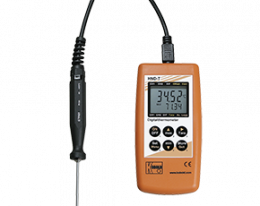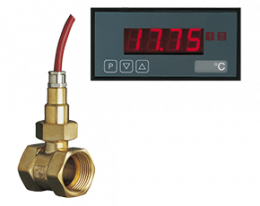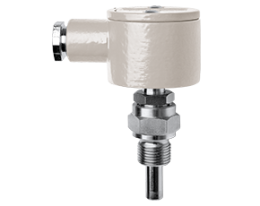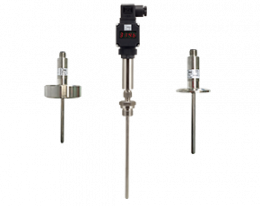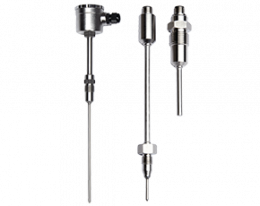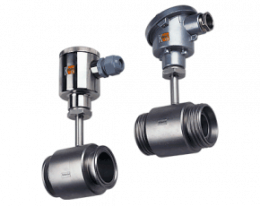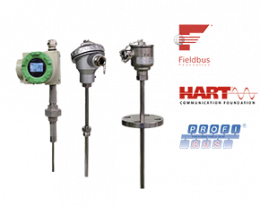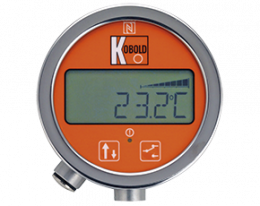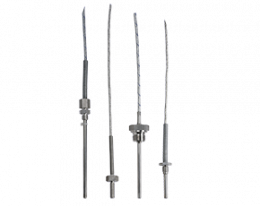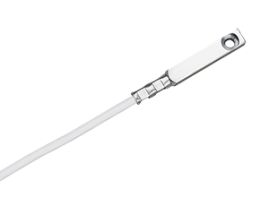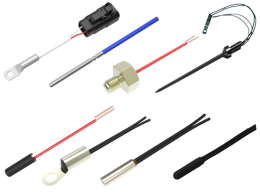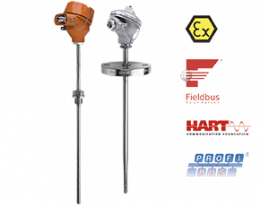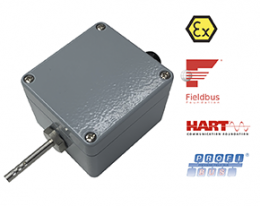KOBOLD Instruments Inc • 1801 Parkway View Drive • 15205 Pittsburgh, PA • Tel: +1 412 788 2830 • E-mail: Please activate JavaScript • visit koboldusa.com
 RTD Temperature Measurement
RTD Temperature Measurement

Frequently Asked Questions – RTD (Resistance Temperature Detector)
What is an RTD temperature sensor?
An RTD (Resistance Temperature Detector) is a type of temperature sensor that measures temperature by correlating the resistance of the sensing element with temperature. Typically made from platinum, RTDs rely on the principle that a metal’s electrical resistance increases in a predictable and linear manner as the temperature rises. This makes RTDs highly accurate and repeatable for temperature measurements. Many RTDs are wire-wound and enclosed in a protection tube, enhancing their durability and shielding them from environmental factors.
RTD sensors are valued for their high accuracy, stability, and repeatability, making them ideal for both industrial and laboratory environments. The sensing element is typically housed in a protection tube to ensure durability and shield it from harsh operating conditions.
There are two common types of RTD sensors:
- Wire-wound RTDs – It is made with fine platinum wire wound around a ceramic or glass core
- Thin-film RTDs – It is constructed with a platinum layer deposited on a ceramic base for compactness and cost-efficiency
Components of an RTD Sensor with Protection Tube
- Connection Head: The section where the sensor connects to the measurement system, ensuring proper signal transmission.
- Process Connection: The fitting that secures the RTD sensor to the process or equipment.
- Electrical Connection: The interface that links the RTD sensing element to the measurement circuit, typically using screw terminals, plug connectors, or lead wires. It ensures a secure and stable transmission of the resistance signal to the monitoring device, minimizing electrical noise and signal loss.
- Insulation: Provides thermal and electrical isolation to prevent interference and improve measurement accuracy.
- Insulated Leads: Wires that transmit the signal from the sensing element to the measuring device, protected from environmental damage.
- Sensing Element: The platinum-based element whose resistance varies with temperature, the heart of the RTD sensor.
- Protecting Tube: A housing that safeguards the sensing element and internal components from harsh environments
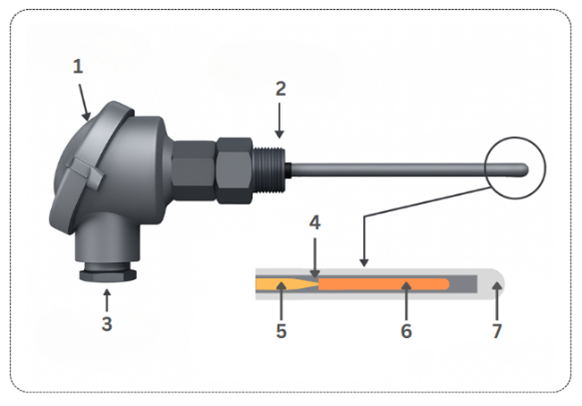
These sensors are widely used across industries for precise temperature monitoring and control, offering long-term reliability and consistent performance.
How Does a Resistance Temperature Detector (RTD) Work?
A Resistance Temperature Detector works on the principle that the electrical resistance of certain metals increases in a predictable and repeatable way as their temperature rises. The most commonly used material in RTDs is platinum, due to its excellent linearity, long-term stability, chemical inertness, and wide temperature operating range.
Working Principle:
An RTD sensor consists of a temperature-sensitive resistance element, usually made of platinum, and a set of insulated wires. When a small, stable electrical current is passed through the resistance element, the sensor measures how much the electrical resistance changes due to the surrounding temperature. As the temperature increases, the resistance of the platinum element increases proportionally. This resistance is measured in Ohms (Ω) and is then converted into temperature values using standardized conversion formulas or calibration curves (like the Callendar–Van Dusen equation).
Wiring Configurations:
RTD sensors come in different wiring configurations to suit various accuracy requirements:
- 2-wire RTD: Simplest form, but affected by lead wire resistance; suitable for less critical applications.
- 3-wire RTD: Most commonly used; compensates for lead resistance and offers a balance of accuracy and cost.
- 4-wire RTD: Provides the highest measurement accuracy by completely eliminating the effect of lead wire resistance; ideal for precision applications.
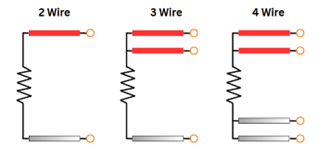
Response Time:
The typical response time of an RTD sensor ranges from 0.5 to 5 seconds, depending on the design, installation, and environment. This makes RTDs well-suited for applications requiring accurate and stable temperature monitoring, especially where long-term reliability is essential
What Are the Different Types of RTD Sensors?
RTD (Resistance Temperature Detector) sensors are generally categorized based on the construction of their sensing element. The two main types are:
Thin-Film RTD Sensors
Thin-film RTDs are manufactured by depositing a thin layer of platinum onto a ceramic substrate. This platinum layer is then laser-cut or etched into a precise circuit pattern to produce a defined resistance. Lead wires are attached, and the element is coated with a protection glass layer for durability.
Key Features:
- Cost-effective and highly reliable
- Compact and easy to integrate
- Greater resistance to vibration and mechanical stress
Wire-Wound RTD Sensors
Wire-wound RTDs use a fine platinum wire wound into a coil. This coil is either enclosed inside or wound around a ceramic or glass core, depending on the application.
Key Features:
- Highly accurate temperature measurement
- Suitable for extreme temperature conditions
- Glass-core types are ideal for liquid immersion
- Ceramic-core versions perform well in high-temperature environments
However, wire-wound RTDs tend to be more expensive and are generally more sensitive to vibrations compared to thin-film types. Do you need help choosing the right RTD sensor for your application? Speak with one of our experienced instrumentation specialists. Our team are here to guide you with expert advice tailored to your specific requirements .
What is the Difference Between RTD and Thermocouples?
Below are the key differences between the two:
- Size and Flexibility: Thermocouples are typically smaller and more flexible than RTDs, making them easier to install in compact or hard-to-reach locations.
- Temperature Range: Thermocouples can measure a much broader temperature range, typically from -200°C to 2000°C, depending on the type. In contrast, RTDs usually operate effectively within a range of -200°C to 600°C. This makes thermocouples more suitable for extreme high-temperature applications.
- Response Time: Thermocouples generally have a faster response time (approximately 0.1 to 1 second) compared to RTDs, making them ideal for processes where rapid temperature changes occur.
- Self-Heating: RTDs can exhibit a self-heating effect due to the electrical current passing through the sensor. This is minimal or negligible in thermocouples, making them more stable in certain environments.
- Sensitivity and Stability: While thermocouples are more sensitive to temperature changes and react quicker, RTDs are known for their higher accuracy and long-term stability, especially in the lower and mid-temperature ranges.
- Linearity: The relationship between temperature and resistance in RTDs is generally linear, simplifying calibration and signal interpretation. On the other hand, thermocouples produce a non-linear voltage-temperature response, requiring more complex signal conditioning.
If you need help selecting the right sensor for your application, speak directly with our industry experts to get tailored guidance based on your process requirements and operational environment.
What are the Applications of Resistance Temperature Detectors (RTDs)?
RTD sensors are widely used across various industries due to their high accuracy, repeatability, and stability in temperature measurement. Below are the primary industries where RTDs are commonly applied, along with explanations for their use.
- Automotive Industry: RTDs are used to monitor engine temperatures, exhaust gases, climate control systems, and battery packs (especially in electric vehicles). Their precision helps improve engine efficiency and emissions control.
- Power Generation and Energy Sector: RTDs are essential in monitoring temperature in turbines, generators, transformers, and power distribution systems. Accurate temperature control ensures operational safety and energy efficiency.
- Consumer Electronics: In consumer devices such as computers, smartphones, and battery-powered electronics, RTDs are used for thermal management to prevent overheating and ensure device longevity.
- Food Handling and Processing: RTDs are widely used in ovens, refrigeration units, and processing lines to maintain proper cooking, pasteurization, and storage temperatures. Their accuracy helps meet food safety and regulatory standards (like HACCP).
- Industrial Automation and Manufacturing: In industrial settings, RTDs are applied in processes requiring precise temperature monitoring — such as chemical production, metallurgy, and plastic molding — to ensure consistent product quality.
- Medical and Healthcare Devices: RTDs are used in diagnostic equipment, sterilization systems, and laboratory devices where precise and stable temperature readings are critical for patient safety and accurate testing.
- Military and Defence Applications: In defence equipment, RTDs monitor temperatures in avionics, radar systems, and control panels, where rugged reliability under extreme conditions is vital.
- Aerospace Industry: RTDs are used in aircraft engines, environmental control systems, and spacecraft where accurate temperature monitoring under extreme pressure and temperature ranges is necessary for safety and performance.
Additional Applications That Can Be Included:
- HVAC Systems (Heating, Ventilation, and Air Conditioning): RTDs help regulate and monitor indoor climate systems with precise temperature feedback.
- Pharmaceutical and Biotechnology: In drug manufacturing and research labs, RTDs are used for maintaining exact temperatures during sensitive processes like fermentation or vaccine storage.
- Semiconductor Industry: RTDs are used in wafer processing and chip manufacturing where even minor temperature fluctuations can affect production yield.
What are the Advantages of Resistance Temperature Detectors (RTDs)?
RTDs offer several advantages that make them a reliable choice for temperature measurement in industrial and commercial applications. These include.
- High Accuracy: RTDs provide precise and accurate temperature readings, often with an accuracy of ±0.1°C or better, making them suitable for processes that require exact control.
- Excellent Repeatability and Stability: RTDs deliver consistent performance over time. Their ability to maintain the same output under repeated conditions ensures dependable long-term use in critical applications.
- Predictable and Linear Output: RTDs exhibit a nearly linear relationship between resistance and temperature, simplifying signal processing and calibration.
- Long Lifespan: Constructed from stable and high-quality metals (typically platinum), RTDs have a long service life and resist degradation, even under continuous operation.
- Wide Operating Range: While not as broad as thermocouples, RTDs effectively measure temperatures from approximately -200°C to +600°C, covering most industrial needs.
- Quick and Reliable Response: RTDs offer relatively fast response times to temperature changes, ensuring timely feedback for temperature control systems.
- Low Drift Over Time: Compared to thermocouples, RTDs experience less signal drift over time, which reduces the need for frequent recalibration .
What are the Disadvantages of Resistance Temperature Detectors (RTDs)?
While RTDs are widely valued for their accuracy and stability, they do come with certain limitations. Below are the key disadvantages of RTDs, along with clear explanations.
- Smaller Temperature Range: RTDs typically operate within a range of -200°C to +600°C, which is narrower compared to thermocouples (which can measure up to 2000°C). This makes RTDs unsuitable for extremely high-temperature applications.
- Higher Initial Cost: RTDs are generally more expensive than thermocouples, both in terms of sensor cost and associated instrumentation. This higher upfront investment can be a limiting factor for cost-sensitive applications.
- Less Rugged in Harsh or High-Vibration Environments: Due to their construction, RTDs are more fragile and less resistant to mechanical shock and vibration compared to thermocouples. This can limit their use in heavy industrial or high-vibration settings like engines or turbines.
- More Complex Measurement Circuitry: RTDs require precise signal conditioning circuits, such as bridge configurations and current sources, to accurately interpret resistance changes. This increases the complexity and cost of the overall measurement system.
- Self-Heating and Lead Wire Errors: When a current passes through the RTD to measure resistance, it can cause slight heating of the sensor, especially in low-temperature or highly sensitive applications .
Why Use an RTD Instead of a Thermocouple?
Choosing an RTD (Resistance Temperature Detector) over a thermocouple depends on the application's accuracy and stability requirements. RTDs are ideal in many industrial and laboratory settings for the following reasons:
- Superior Accuracy and Stability: RTDs provide highly accurate and consistent temperature measurements. Their predictable and nearly linear resistance-temperature relationship allows for reliable and repeatable readings over time.
- Excellent Performance in Moderate Temperature Ranges: While RTDs typically measure temperatures from -200°C to +600°C, they deliver better precision within this range compared to thermocouples, making them ideal for processes requiring tight temperature control.
- Less Susceptible to Electrical Noise: RTDs produce stable signals that are less affected by electrical interference, making them suitable for sensitive industrial environments.
Want to ensure the right temperature sensor for your setup? Talk to our industry experts for personalized assistance
Can We Use a Thermocouple Instead of an RTD?
Yes, a thermocouple can be used instead of an RTD in certain applications, depending on your process requirements and environmental conditions. However, several factors should be considered:
- Wider Temperature Range: Thermocouples are capable of measuring a broader temperature range (up to 2000°C, depending on type), which makes them suitable for high-temperature applications where RTDs may not be effective.
- Faster Response Time and Ruggedness: Thermocouples generally respond more quickly to temperature changes and are more durable in harsh, high-vibration, or corrosive environments.
- Cost-Effective Option: Thermocouples are typically less expensive than RTDs, both in terms of sensor cost and associated electronics, making them a preferred choice in budget-sensitive applications where extreme precision is not essential.
What Causes RTD (Resistance Temperature Detector) Failure?
RTDs are generally reliable and durable sensors, but like any electronic component, they can fail over time or under harsh operating conditions. Common causes of RTD failure include:
- Mechanical Damage: Physical impact, bending, crushing, or abrasion of the RTD element or lead wires can result in permanent damage or disconnection, leading to sensor failure.
- Exposure to Excessive Temperatures: Operating the RTD outside its specified temperature range can degrade the sensing element or insulation material, resulting in drift, loss of accuracy, or total failure.
- Moisture Ingress and Chemical Contamination: Moisture or corrosive substances can penetrate the sensor or cable insulation, causing corrosion, short circuits, or resistance instability.
- Vibration and Mechanical Shock: Continuous vibration or repeated mechanical shock can break internal connections, loosen wiring, or cause fatigue in sensor components, leading to intermittent faults or open circuits.
- Ageing and Natural Wear: Over time, RTD elements and their insulation materials may degrade, particularly in demanding environments. This natural wear can affect performance and accuracy.
- Improper Installation: Incorrect wiring, lack of strain relief, poor insulation, or improper sensor placement can lead to electrical faults, mechanical stress, or environmental exposure, increasing the likelihood of sensor failure.
What Are the Different Types of RTDs Available?
1. Insertion Temperature Sensors with or without Transmitter: These sensors are designed for direct installation into process systems such as pipes or tanks. They can include built-in transmitters and optional digital displays, making them ideal for real-time monitoring. Their robust build allows them to handle higher pressures and temperatures, and the modular design enables easy replacement or upgrades.
Common Applications:
- Heating systems
- Industrial machinery
- Marine systems
- Food and pharmaceutical processing
To know more about this product, speak to our industry expert or visit the product page.
2. Compact Resistance Temperature Sensors: These are versatile and compact RTDs that suit space-limited installations. They offer quick response times and can be configured with or without transmitters, making them flexible for different output and connectivity needs. These sensors are often used where precise temperature control is essential, including sanitary environments.
Common Applications:
- Food and beverage industries
- Hygienic environments
- High-temperature monitoring
- Compact or enclosed equipment setups
To know more about this product, speak to our industry expert or visit the product page.
3. In-Line Pipe Temperature Sensors (Dead-Zone-Free): This type of RTD is engineered for inline installation in pipelines, ensuring there are no dead zones or flow disruptions. These are especially useful in applications requiring hygienic and contamination-free conditions. They support full clean-in-place (CIP) protocols and are available with optional transmitters.
Common Applications:
- Dairy and beverage processing
- Pharmaceutical and cosmetic production
- Paints and liquid media handling
- Industries requiring strict hygiene control
To know more about this product, speak to our industry expert or visit the product page.
4. Heavy-Duty Resistance Thermometers: These RTDs are designed for high-demand environments. With rugged construction and optional digital communication (e.g., 4–20 mA, HART®, Fieldbus®), they are suited for temperature measurement in liquids, gases, and solids. Some versions allow the sensing element to be removed without stopping the process.
Common Applications:
- HVAC systems
- Petrochemical and chemical industries
- Heating and cooling processes
- Machinery and plant equipment
To know more about this product, speak to our industry expert or visit the product page.
5. Screw-In and Insertion RTDs: Built for durability, these RTDs are ideal for both dry and moist industrial settings. They come with various thread options and can be used in simple or rugged conditions. The cable exit is protected with strain relief, ensuring long-term reliability in dynamic environments.
Common Applications:
- Furnace and apparatus construction
- General industry installations
- Mechanical equipment
- Gaseous and liquid process media
To know more about this product, speak to our industry expert or visit the product page.
6. Contact-Based Surface RTDs: These sensors are mounted externally on pipes or surfaces and offer a non-invasive method of temperature monitoring. They are ideal for applications where direct contact with the medium is not possible or desirable. Installation is quick and simple, requiring no modification to the process system.
Common Applications:
- Piping systems
- Closed tanks or surfaces
- Building systems and machinery
- Temperature measurement without fluid exposure
To know more about this product, speak to our industry expert or visit the product page.
What is the Typical Measuring Range of RTDs?
RTDs are built to operate within defined temperature limits based on their sensor type and application:
- Standard RTDs cover a general measuring range of -50°C to +250°C.
- Advanced or cryogenic models extend down to -198°C, and specialized high-temperature models can operate up to +600°C.
Lower range models are suitable for applications such as HVAC or food processing, while extended-range sensors are preferred in energy, chemical, and pharmaceutical sectors.
It’s important to match the sensor’s measuring range to your specific process requirements to ensure accuracy, safety, and long-term reliability.
What Materials Are Used in RTD Sensor Construction?
RTDs are primarily constructed using stainless steel for the protection tube and process connection due to its durability, corrosion resistance, and hygienic compatibility. The material grade often used is 1.4404 (316L stainless steel) for food and pharmaceutical applications.
Other materials used include: PTFE, PVC, silicone, or glass-fiber braided cables depending on required insulation, temperature tolerance, and environmental conditions.
Material selection ensures long-term performance under mechanical stress, moisture, pressure, or aggressive media exposure.
What Temperature and Pressure Conditions Can RTDs Handle?
RTDs are designed to operate under varying conditions of temperature and pressure, depending on their construction:
Temperature Range: Most industrial RTDs operate reliably from -70°C to +250°C. Certain models are suitable for cryogenic applications (-198°C) or extended use up to +600°C in high-temperature environments.
Pressure Resistance: RTDs can withstand pressures typically between 10 bar to 36 bar, depending on the mechanical design and process connection (e.g., screw-in, flanged, or weld-in).
Enhanced Durability: Models with neck extensions or reinforced connections are used in environments involving high thermal load or vibration.
To ensure safety and precision, always verify the rated limits of the RTD sensor for your specific application. To know more about our RTDs with high temperature and pressure tolerance, refer to the product page.
Are RTD Sensors Certified for Use in Hazardous Environments?
Yes, many RTD (Resistance Temperature Detector) sensors are available with certifications that allow them to be safely used in hazardous or explosive environments. These certifications ensure that the sensor meets strict safety requirements for electrical and thermal performance under potentially dangerous conditions.
For example, some RTDs come with ATEX certification, which is a widely recognized standard for equipment intended for use in explosive atmospheres. Such certified sensors are commonly used in industries like oil & gas, chemical processing, and pharmaceuticals where flammable gases or dusts may be present.
Important: Certification can vary depending on the specific sensor model, configuration, or installation method. Always confirm the exact certification status with your manufacturer or supplier before selecting an RTD for hazardous area applications.

